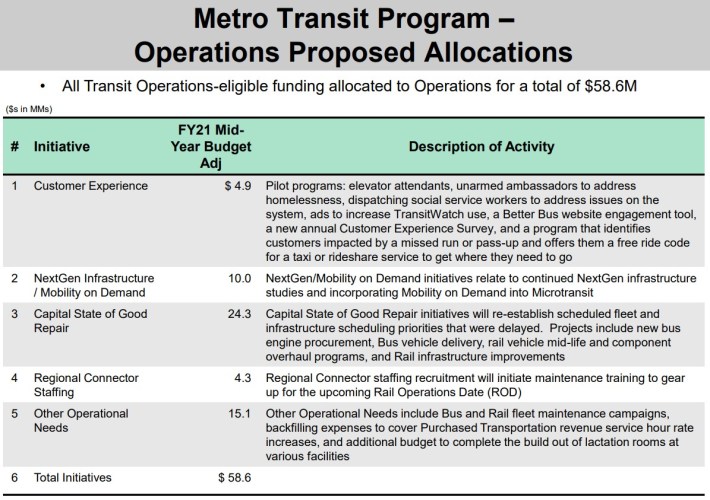Metro has unexpected revenue, but the agency is bending over backward to avoid spending a penny on restored transit service.
When COVID hit last year, Metro sales tax revenue dropped, leaving a hole in Metro's budget. Metro received some relief - $846 million - from the initial CARES Act federal stimulus. The agency undertook several cost-saving measures, including cutting bus service by 20 percent in September 2020. At the time, riders spoke out against the cuts. Metro CEO Phil Washington and operations staff assured boardmembers that the agency could scale service back up responding to crowding and rebounding ridership. The Metro board passed a motion directing staff to report back every other month on how the agency plans to restore service.
This week, Metro finances are looking better than projected - primarily due to better-than-anticipated sales tax revenues. The board Finance Committee voted to approve a mid-year budget adjustment (staff report, presentation) that adds back $765 million to the remaining months of the fiscal year. There is also $34.3 million that had been budgeted to pay for debt, but refinancing made that money available now. The total midyear budget increase is nearly $800 million.
Metro will also soon receive $750-850 million from the second round of federal stimulus, approved in December.
(Can't count these chickens yet, but newly inaugurated President Joe Biden is pushing for even more COVID stimulus. As of now, the next stimulus bill proposes $20 billion for transit systems nationwide.)
With more than $1.5 billion in unexpected funds, Metro must be putting back some of that bus service, right?
Nope.
COVID has decimated transit nationwide, but with @metrolosangeles revenues looking up and potential federal $$$ on the horizon, our priority has to be aggressive service restoration. Many essential workers are transit-dependent, and they are relying on us. https://t.co/vDoyezqNqW
— Mike Bonin (@mikebonin) January 21, 2021
Lots of info coming out about Metro's budget being in better shape than we thought. First order of business must be restoring bus service. @All4Transit and partners will be organizing for the Board meeting next week- stay tuned. https://t.co/ZqmSLue4Dm
— Laura Raymond (@laurajraymond) January 21, 2021
Metro hasn't programmed the $750+million in federal stimulus monies, but there is a staff proposal for the $765+million in extra local revenue. Of that, $741 million would go to capital projects. Just $58.6 million would be funneled toward operations, but would not actually increase transit service.

Metro proposes to spend operations money on State of Good Repair ($24 million), "other operational needs" ($15 million - see description in chart above), additional MicroTransit and NextGen bus speed improvements ($10 million. It's unclear why these unrelated expenses are bundled; and bus lanes are cheap), a Customer Experience ambassador pilot ($4.9 million), and staffing up for the Regional Connector opening in 2022 ($4.4 million.)
To some extent, the predominance of spending on capital projects is baked into Metro's sales tax measures, which earmark percentages for various types of expenditures.
There is some flexibility, however. Metro is choosing to avoid funding bus service in that $58.6 million. Why choose to fund converting the agency's expensive Mobility-on-Demand pilot into its expensive MicroTransit pilot? Why prioritize staffing recruitment for the 2022 opening of the Regional Connector during the current budget crisis? Why not target more of the customer relations pilot when customers return? What's the deadline for building out lactation rooms (mandated by a newly-passed California law)? Surely if there is the political will to provide for bus riders, there are millions - perhaps tens of millions - that could be directed toward restored service.
Metro transit operations leadership appears to be betting on depressed ridership continuing through the end of fiscal year - June 30, 2021. This is likely to mean infrequent bus and rail service, leading to overcrowding as the county gradually recovers from COVID.
As COVID spiked, Metro ridership declined from a COVID high of 615,000 in October to 475,000 in December, but is already rebounding in January.

One reason that ridership is down and one complication in restoring cut bus service is that COVID is currently impacting Metro's operations workforce.
On top of the cuts, Metro is reporting missed service due to increased employee absenteeism (a broad category that includes illness, vacation, etc.). At this morning's Operations Committee, Metro Chief Operations Officer James Gallagher reported that operations staff absenteeism increased from a pre-COVID average of 31.6 percent to 46.1 percent during 2020. Gallagher reported that Metro is currently recruiting new bus operators, though he also stated that it takes eight weeks to train staff before they operate a bus. The lag time means that it will be difficult to ramp up bus service as ridership returns.
The revised mid-year budget item (with no additional bus service) was approved by the Metro Finance Committee yesterday, but still needs final approval from the full board at its meeting next Thursday, January 28.







